You have set up a firm. Now you would like to go ahead and inform people about your offerings. Firstly, you spread awareness about your products and offerings in your own city. Then you slowly expand to other cities in the country. Congratulations! You have a multi-million dollar business. But that is not enough. Now, you want to take it a step further. You want to take your product to the world. This is where international marketing comes in.
We will be discussing all aspects of this international marketing article.
Table of contents:
- What Is International Marketing?
- How To Get a Competitive Advantage With International Marketing?
- What Is The First Step In The International Marketing Research Process?
- How Does International Marketing Differ From Domestic Marketing?
- What Are The Strategies to Enter an International Market?
- Digital International Marketing Strategies to Enter a New Market
- Marketing Mix Decisions In An International Context
- How Does The Cultural Environment Affect International Marketing Activities?
- How To Do International Marketing to a Service Company?
- Should You Hire An International Marketing Agency?
- Evaluating the Success of International Marketing Campaigns
- The Future of International Marketing
What Is International Marketing?

Many people have defined and redefined the concept of international marketing. Simply put, international marketing is the process of application of marketing principles across national boundaries.
Also, the need for international marketing arises due to a change in consumer tastes and preferences.
Let us take a look at the core concepts of international marketing.
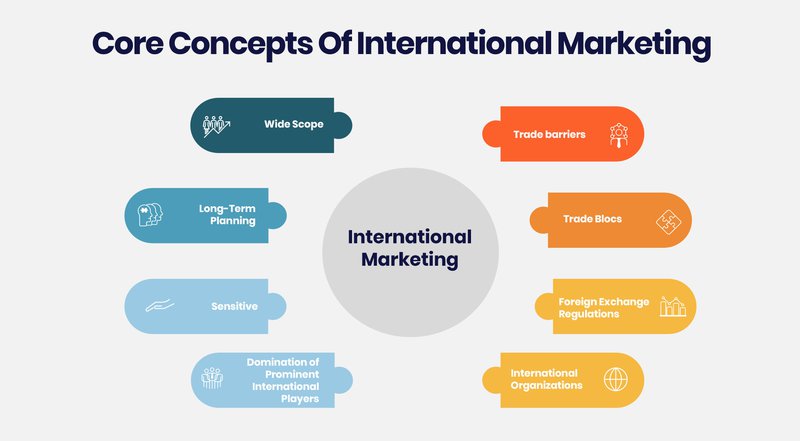
1) Wide Scope
A diverse range of activities, including international marketing research, product planning, development, and adaptation, fall under international marketing. Also, several other aspects, such as packaging, communication, and branding, need to be taken into account.
2) Long-Term Planning
Due to the complexities involved, international marketing requires long-term planning and vision. The dynamics of international marketing are tough to navigate because of the political, economic, and social factors involved. So, one must have a high level of adaptability.
3) Sensitive
International markets are highly sensitive in nature. Changes in technology, regulation, or increased competition from local brands may lead to a sudden fall or jump in sales.
4) Domination of Prominent International Players
Your brand will have to compete against larger established entities from other parts of the world to gain a respectable market share.
5) Trade barriers
These form part and parcel of international marketing. Trade barriers are man-made barriers to the movement of goods across the world. There are two types:
- tariff barriers
- non-tariff barriers
Tariff barriers come in the form of taxes and customs duties. On the other hand, quotas and licenses are typical forms of non-tariff barriers.
6) Trade Blocs
Countries that follow a standard/common set of laws and regulations while trading is known as trade blocs. The EU and the NAFTA (North American Free Trade Association) are examples of trade blocs.
7) Foreign Exchange Regulations
All countries have different currencies and exchange rates. Therefore, they also have their own rules governing payment and collection of foreign currency.
8) International Organizations
Bodies like the World Trade Organization (WTO) and the United Nations Conference on Trade and Development (UNCTAD) lay down the framework for international trade.
These organizations help promote international trade. Also, they establish an environment where underdeveloped nations can enhance their export potential.
How To Get a Competitive Advantage With International Marketing?
International marketing can provide businesses with a competitive advantage by expanding their reach beyond domestic borders. Here we list some important factors to reach a competitive advantage with international marketing.
Get Increased Sales With Business Expansion
By targeting global markets, companies can tap into new customer segments and diversify their revenue streams. Additionally, international marketing allows businesses to gain insights into different cultures and consumer behaviors, enabling them to tailor their products or services to specific market needs.
Increase Brand Recognition: Build an International Brand With Consistent Branding
Moreover, utilizing digital platforms and social media channels allows businesses to reach a wider audience at a fraction of traditional advertising costs. By creating engaging content that resonates with diverse cultures, companies can establish brand credibility and loyalty across borders.
Have A Deep Understanding Of The International Business World and Product Demand
To be effective, businesses must employ effective tactics that leverage the power of global business.
Identify untapped opportunities and understand cultural nuances. This involves analyzing consumer behavior, preferences, and trends in different countries and tailoring marketing campaigns accordingly. We will talk more about it in the next section.
New Products or Services: Unique Products Or Service Offerings To The Host Country
To reach the competitive advantage you need in the international business world, consider offering unique products or services that set you apart from your competitors. By providing innovative and distinctive offerings, you can attract customers who are looking for something different and stand out in a crowded marketplace. This can help you establish a strong brand identity and increase your chances of success in the global business arena.
Collaborating on Business Operations
Another vital aspect is building strong relationships with local partners or distributors who possess knowledge of the target market. Collaborating with these partners can help navigate regulatory challenges, language barriers, and customs requirements.
Additionally, investing in cross-cultural training for employees ensures effective communication and understanding of international customers' needs.
Ultimately, by embracing informative tactics and adopting a global mindset, businesses can unlock the power of international marketing and gain a competitive edge in today's interconnected world.
What Is The First Step In The International Marketing Research Process?
It can be easy to feel overwhelmed when it comes to international marketing research – but that’s only if you don’t know where to start. The first step is identifying what you need to do in order to get started. This will help you determine your specific needs and help you avoid making any common mistakes. Here are the topics to guide you:
- Business needs assessment
- Market research study
- Business opportunity assessment.
What is a Business Needs Assessment?
A business needs assessment is the first step in the international marketing research process. It is a way to get a detailed understanding of your business and what you need in order to grow.
It is a way to determine what your business needs to succeed. This includes everything from financial information to customer demographics.
What is a Market Research Study?
A market research study is the second step in the international marketing research process. It is a way to gather information about your target market and how they may react to your product or service.
What is a Business Opportunity Assessment?
A business opportunity assessment is the third step in the international marketing research process. It is a way to determine if your business is a good fit for the target market. This includes assessing your competitors and determining if your product or service offers a unique solution.
How Does International Marketing Differ From Domestic Marketing?
It is no secret that the world is becoming increasingly globalized. Gone are the days when businesses operated in a vacuum and only marketed to their own country. Increasingly, businesses must operate in a world where different cultures and markets are considered.
Now more than ever, businesses must learn how to differentiate their products and services from their competitors using domestic or international marketing.
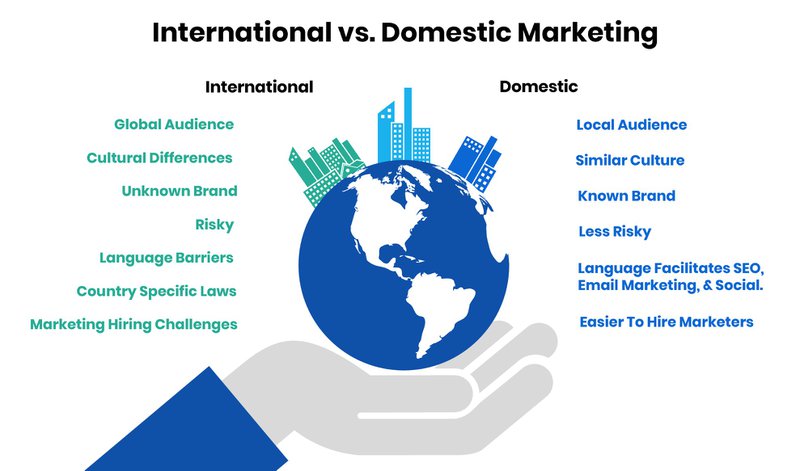
International marketing is the marketing of products and services to consumers and businesses outside of the company’s country of origin, while domestic marketing is within the company’s country of origin.
Domestic marketing focuses on reaching a population already familiar with your brand or product. On the other hand, international marketing is geared toward reaching a wider audience. This means it considers the cultural norms and preferences of those marketing your product or service.
What Are The Strategies to Enter an International Market?
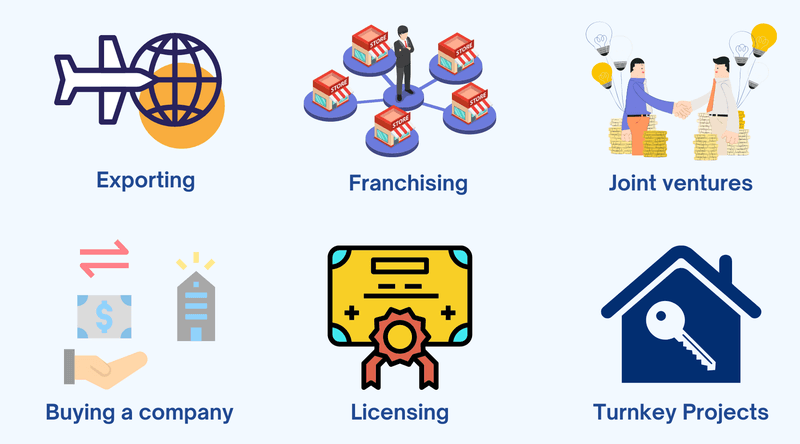
Market entry strategies play a pivotal role in the success of your international marketing efforts. The choice of a market entry strategy depends on the marketing strategy's goals. Let us look at these strategies in this section.
1) Exporting
This is the easiest and the most commonly adopted way to enter a new market. Firms can directly sell the products they manufacture without involving agents or third parties. This is known as direct exporting.
However, if a company starts in an international market, it might use a network of agents such as international distributors. Moreover, this approach works because the agents have experience in their fields, and all that the company has to do is pay them a fee.
2) Franchising
This is another standard method to break into new markets. Franchising is a model where the individual or the buyer agrees to manage a firm’s branches on their behalf. They have to pay a fee and a portion of the profits.
Franchising works well if your brand already enjoys a reputation and recognition internationally. There is a certain amount of risk as you allow other people to become a part of your business. However, it allows you to earn profits while adopting the indirect management approach.
3) Joint Ventures
Some companies enter an international market by forming a partnership with other firms. Consequently, this results in a win-win situation for both of them. They minimize their risks.
Also, they stand to earn more revenue. But, there is a chance of skewed company involvement. However, proper paperwork and the establishment of processes help solve these issues.
4) Buying a Company
This one ranks right up there as one of the easiest ways to make your presence felt in an international market. Like with everything else, there are advantages and disadvantages to this approach. You have an existing market share and brand image.
Also, you get to skip most of the rules and regulations since they treat you as a local firm. But this method is expensive. And it is challenging to maintain a cohesive brand image as the new firm has its own culture.
5) Licensing
This is a method where a company transfers the rights to use or sell a product to another firm. However, in most cases, this is a temporary arrangement. Also, this is a preferred method if one firm has an in-demand product and the other organization has access to a large market. An example of this is comic character merchandise.
But licensing is not necessarily straightforward. You will have to convince your partner firm of the potential of your product. And then, there are legal formalities and procedures to take care of.
6) Turnkey Projects
These are generally construction or engineering projects. The term turnkey refers to the client getting an utterly functional facility built from scratch and just having to turn a key to start running it. These are large, high-value, and prestigious projects. Also, these are usually government projects and could be funded in part by foreign monetary institutions.
How To Get a Competitive Advantage With International Marketing
Digital International Marketing Strategies to Enter a New Market
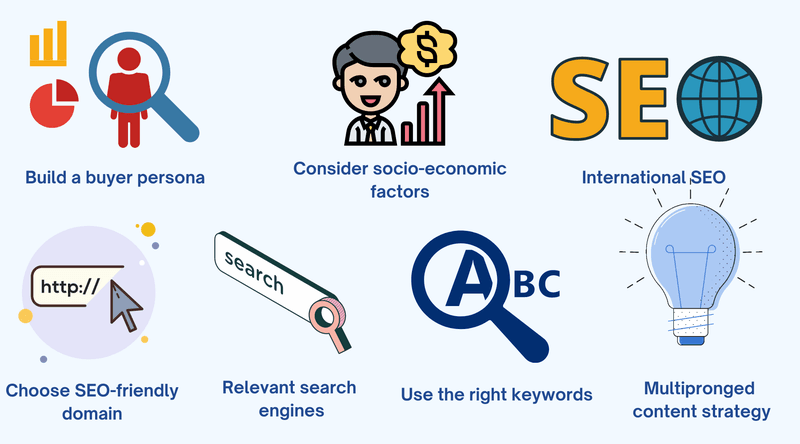
When we speak of marketing, can digital media be far behind? No way!
This section examines effective digital international marketing methods that every campaign manager or business manager must consider.
Build A Buyer Persona.
The first step is identifying the right kind of customers for your brand. For this, you need to collect data and develop engaging content for your audience. A buyer persona should consider all relevant factors like location, age, gender, industry, income, and job title.
Study The Socio-Economic Factors.
You must relate to the audience's mindset to sell your product. This will require studying local incomes, spending habits, customs, and culture. Using precise demographic and psychographic data in your campaigns will yield the best results.
International Search Engine Optimization (SEO).
This is a crucial peg in your international marketing strategy. People should discover your website to know about your product. Let us look at some techniques to create an SEO-friendly website.
1) Choosing An SEO-Friendly Domain.
Building a separate website will help enhance the user experience. There are two options when choosing a domain. Country Code Top Level Domain (ccTLD) ends in a country-specific code and General Top Level Domain (gTLD) that can be paired with extensions such as .com or .org. ccTLDs are seen as more trustworthy but require extensive SEO.
However, gTLDs derive their authority from the parent domain and are more beneficial in the long term.
2) Optimize For Relevant Search Engines.
Knowing the most commonly used search engine in your target market is essential. Google is the dominant search engine. But Bing is more prevalent in some places.
Also, countries like Russia and China use homegrown search engines such as Yandex and Baidu, respectively. Different approaches must be used as all search engines have their own algorithm.
3) Using Keywords In The Target Language.
Search terms and keywords that are frequently used in the target language will help enhance search rankings. Also, you can hire people who are fluent in the local language. They will assist in keyword research and ensure that you have an optimal keyword strategy in place.
4) Use A Multi-Pronged Content Strategy.
One should have several pegs to their content strategy. This includes :
- Creating multilingual blogs will expand the reach of your brand. A blog will establish you as a thought leader and build a unique identity for your blog.
- Amplifying user-generated content – One should share user reviews, stories, and experiences around the product. This creates a connection between the local community and the brand.
The Use Of Social Media In International Marketing
A couple of aspects must be examined while working on a global social media strategy. One cannot simply pick up posts, translate them, and copy-paste them to their target audience.
Instead, one needs to bring experienced translators on board. This will help avoid gaffes that could backfire and result in potential lawsuits.
Another thing to remember is to add a local flavor to your campaigns. This is the only way you will connect with your target audience. You must understand what the consumer likes, what sells, and how to sell it.
Lastly, you must know the platforms that dominate your target market. This will enable you to create a highly tailored strategy.
For instance, TikTok, Instagram, and YouTube may be prominent in the US. But WhatsApp rules the roost in India. And China has its own social media ecosystem comprising – WeChat, Tencent Weibo, QQ, and Kuaishou. Similarly, Kakaotalk is popular in Korea, and LINE is in vogue in Japan.
When it comes to Europe – France and Germany have their LinkedIn-style platforms. Viadeo and XING, respectively. Russia is another country that has its own set of social media platforms – Vkontakte, a Facebook clone, and Odnoklassniki – a video and image-sharing website.
Africa has been home to a few local platforms that failed to take off. So, one needs to use Facebook, YouTube, and Twitter to tap into the market there. Likewise, Sonica and Orkut were significant players in Latin America before they shut down. An Argentinian platform called Taringa has a significant presence.
Emails In International Marketing
When considering email marketing while designing an international marketing campaign, one should realize that one country's click and open rates are entirely meaningless in another.
Also, the tone and content of your newsletters must be different for each country. Also, the way you build your email list will vary across regions.
Moreover, the data quality will not be consistent as well. This is due to the data collection and privacy laws in force. So, international email marketing requires a highly customized strategy.
Marketing Mix Decisions In An International Context
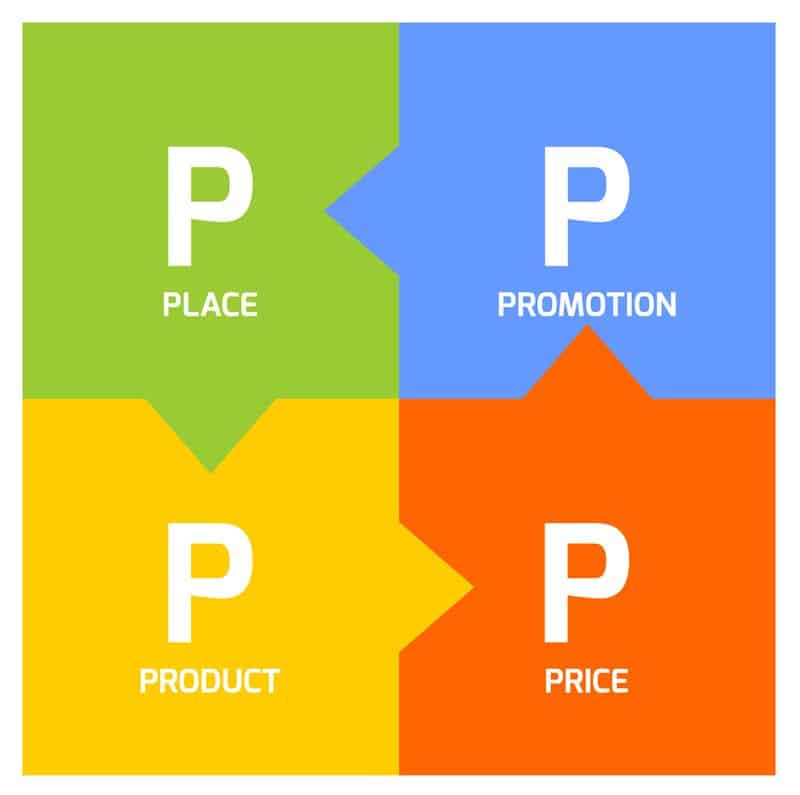
The P’s of marketing need to be adapted per the region one is serving. To go in with the mindset of the home country would be committing hara-kiri. In this section, let us look at how the basic elements of marketing are internationalized.
Product
The decision of whether a product should be standardized or localized in an international market is at the crux of a brand’s strategy. McDonald's is adept at localizing its offerings to local tastes and preferences. Product has to be the focus of any business.
For instance, burgers will not contain beef in India as the cow is a sacred animal. Instead, they use chicken or fish. In Mexico, the burgers are served with chili sauce.
However, brands such as Nike and Apple sell the same products worldwide. This works for them as it aligns with their image of an aspirational brand.
Price
The pricing of a product in an international market is arrived upon after looking at several factors, including:
- Transportation costs
- The prevailing Exchange rate
- Tariffs or import duties
- Income of the target market
- Mode of selling – offline or online
- Prices of competitors.
The internet has made things trickier as consumers can now compare the prices of different products online. So any firm now has to be highly thoughtful while arriving at a pricing strategy for their products.
Promotion
As with the product, the most significant decision to make here is whether to localize or standardize the promotional messaging. One should be cautious here. Due to cultural differences and mindsets, the same colors, numbers, symbols, or words carry varying meanings in different places.
For instance, the color white is associated with brides in the US, UK, and China but with death and mourning in India. Also, the kind of media consumed must be taken into account – TV, radio, newspapers, or streaming services.
Place
The place component focuses on providing the product to the consumer when and where he needs it. Goods typically move from the manufacturer to the wholesaler and finally to the retailer. However, the number of intermediaries varies from one country to the next.
Japan, for example, has five different types of wholesalers involved in the distribution chain. Also, businesses need to look at transportation costs and profit margins before finalizing the distribution strategy.
How Does The Cultural Environment Affect International Marketing Activities?
Cultural norms should get their due attention in international marketing. Here we look at the various cultural aspects that must be addressed in a foreign market.
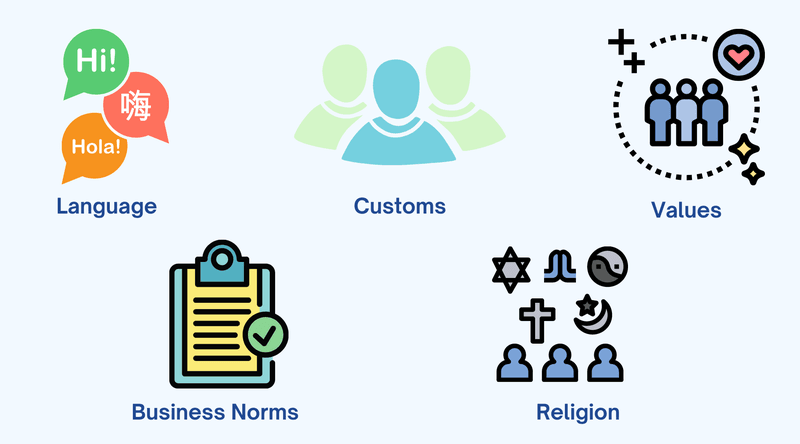
Language
People speak a few thousand different languages the world over. In many countries, the dialect changes every few miles. Nations like India are home to more than twenty official languages. Similarly, many languages are spoken in China as well. This is a nightmare for marketers.
There are many embarrassing instances, such as when General Motors marketed its car Nova in Latin America. The word ‘Nova’ translates to ‘it won’t go in many local languages there. Also another interesting fact is that Russia has a negative perception in many former Soviet nations.
Customs
As discussed earlier, marketers need to know what different symbols, colors, numbers, and words mean in other countries. For instance, the number 4 is considered unlucky in China and Japan. This is similar to bad luck being associated with the number 13 in America. Firms must bring on board cultural experts to deal with such issues.
Values
Values help determine what is acceptable and unacceptable in a society. These values influence consumer behavior in exciting ways. People in the US tend to be more individualistic, whereas, in Japan, there is a focus on the group's well-being. These differences show up in advertising in these respective societies, thus making it essential for a marketer to take note of them.
Business Norms
The way of conducting business varies starkly from country to country. For example, everyone on the team is invited to air their views in a meeting in the US. However, in Japan, senior colleagues are expected to lead the discussion with little contribution from junior colleagues.
Even the greetings are different. In Asian societies such as Japan and India, a respectful bow or the traditional namaste is the preferred business greeting, whereas a handshake is preferred in the US.
Religion
This is one of the strong influencers on the consumption habits of people. Also, they influence when people indulge in shopping. Festive seasons differ all over the world. In the West, Thanksgiving and Christmas are celebrated towards the end of the year.
However, the Chinese New Year festivities happen in February or March. Eid is celebrated in April or May. Religion also shapes a region’s food habits. Eating meat is forbidden in the Jain community in India.
Likewise, alcohol is prohibited in Islam. It is essential to take note of religious sensitivities to prevent an utterly avoidable PR disaster for the brand.
How To Do International Marketing to a Service Company?
To successfully implement international marketing strategies for a service company, several key factors should be considered. They are similar to any business in general but with some peculiarities.
Firstly, conducting thorough market research becomes even more crucial as services often rely heavily on cultural nuances and local preferences. Businesses can tailor their services to meet specific needs.
Also adapt your pricing strategy, as economic factors and purchasing power may vary across different countries. Overall, a well-executed international marketing strategy can open up new avenues for growth and establish your service company as a global player in the industry.
Establishing a strong online presence is crucial for service companies in international marketing. This involves creating localized websites or landing pages to cater to the specific needs of customers in different countries. By providing relevant content, testimonials, and case studies, you can build trust and credibility with potential customers abroad.
Additionally, leveraging digital platforms and social media networks popular in the target market can help effectively engage with potential customers and build brand awareness.
Identify local influencers or industry experts who have a strong presence in your target market and explore opportunities for collaboration. By partnering with them you can be related to their credibility, a fundamental factor for getting new customers in a service business.
Remember, international marketing for a service company requires careful planning, research, and adaptation to ensure success. Stay attuned to cultural nuances, language preferences, and market trends to effectively position your services in a global context.
Should You Hire An International Marketing Agency?
When you hire an international marketing agency, they will help you increase your exposure by creating strategic marketing plans and campaigns targeting specific global markets. This will help you reach a wider audience and reach new heights.
Here are some other pros of hiring an international marketing agency.
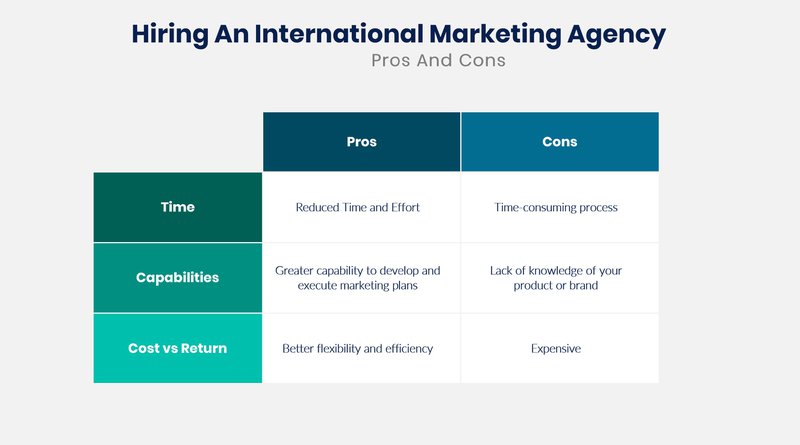
Pros of Hiring An International Marketing Agency:
- Reduced Time and Effort: An international marketing agency will take care of your marketing tasks, from branding and logo design to online marketing and social media campaigns. This will free up your time to focus on other business tasks that are more important.
- Greater capability to develop and execute marketing plans: As they will probably have local teams, they will know better the audience and resources needed.
- Better flexibility and efficiency: If you’re like most business owners, you want to be as flexible as possible when it comes to your marketing strategy. An international marketing agency can help you achieve this by catering to your specific needs and preferences.
Cons of Hiring An International Marketing Agency:
- Time-consuming process.
- Lack of knowledge of your product or brand: An international marketing agency may not have the same level of expertise as you do when it comes to marketing your business overseas.
- Hiring an international marketing agency can be expensive, especially if you need them to develop a comprehensive global marketing plan.
Evaluating the Success of International Marketing Campaigns

You have an international marketing strategy in place. You have decided on your mode of entry, digital marketing efforts, and product mix. Awesome! Now it is time to measure the success of your work. This depends on several factors that are discussed here:
Goals
Firstly, it is necessary to have well-defined goals. This will help you have a benchmark against which you can measure yourself. Also, it is essential to break down these goals into the following:
- Short-term (1 year)
- Medium-term (1-3 years)
- Long Term (5 years +)
Your short-term goal can be establishing a brand presence in your target market. After completing the initial research, you create a presence that ensures that your brand has a top-of-the-mind recall.
Also, the focus has to be on building a loyal community of users that can give you word-of-mouth publicity. A medium-term goal can be to be one of the top four players in the market. And a long-term goal can be to be the number 1 player in the chosen market.
Most importantly, you need goals to give direction to your marketing strategy. Moreover, you can reorient your approach depending on your progress.
Local market context
Each international market is at a different stage in terms of income, penetration of digital media, and so on.
For instance, a developed market like France is already in the advanced stage of mobile phone adoption. So they are less likely to try new apps. However, in markets like Brazil, smartphone use is on the rise. This presents an excellent opportunity for marketers to acquire customers at a lower cost.
The lesson here is that collecting accurate local data across different markets is a must for the success of your international marketing efforts.
Test your localization strategy
You have collected data. Excellent. Now you want to go and adjust your marketing mix as per the local market. Before a complete rollout, testing the localized marketing mix with a smaller sample size is always advisable. This way, you can quickly understand the market's response, experiment, and, most importantly, course-correct.
In the end, the success of your international marketing strategy comes down to numbers like customers acquired, churn rate, repeat customers, average sale size, and overall sales.
The Future of International Marketing
The progress of international marketing depends on how the brand can ultimately benefit society. Besides providing convenience to customers or allowing them to lead better lives. Can it also uplift the lives of the local communities? Brands must also look for partnerships with local creative agencies to market their product better.
Also, in a world where data privacy is gaining momentum daily, they need to rethink their digital advertising strategies. Brands that are expanding internationally need to focus on providing the ultimate online, in-store, and after-sales experience to gain the trust of their customers.
Here are some of the biggest trends that we see as the driving force behind international marketing going forward
Consumers Know What They Want
As consumers, we have a lot of power. We can help determine what companies produce and run campaigns for us. Today, consumers are more empowered than ever, with the ability to tell companies how they want to be marketed, who they want to hear from, and what they want their interactions to look like.
This shift will continue as people become more aware of their power in choosing their marketing tactics, and companies must adapt. This change has also caused international markets to prioritize online marketing methods over traditional ones.
Many people are turning towards social media platforms because they’re a more interactive way of connecting with businesses, have better conversion rates, and provide a less expensive way of reaching customers than traditional forms of advertising.
Social media platforms have been increasingly popular in international markets, which helps explain why Facebook is one of the most effective ways for brands to advertise abroad.
Faster Than Ever: The Speed of Consumer Tech Habits
As consumers live a more mobile lifestyle, they have less and less patience for anything that doesn't allow them to keep up with their daily lives. That means that there’s a growing need for companies to be able to reach customers wherever they are through just about any device.
In particular, it's essential for businesses to stay on top of the latest trends in technology so they can offer their customers what they want. The rise of social media has created an ever-growing demand for brands that are able to connect seamlessly with these platforms.
More specifically, it's essential for companies to develop apps that answer their customer’s needs and meet their expectations. As convenience becomes more important than ever, we'll see this trend continue into the future as well.
Pay-For-Content Is On the Rise
Pay-for-content is a trend that we see continuing to gain momentum. Consumers are more likely to engage with and share content when it’s given to them for free and rewarded in some way.
The key here is that the content should be valuable, entertaining, and informative. To successfully implement this as an international marketing strategy, you want your content to be engaging and relevant for your target audience.
We also expect this trend to continue going forward as companies shift their focus from brand awareness to driving sales through high-quality consumer engagement.
Robots Are Taking Over
The future of international marketing is still uncertain, but one thing we can be sure of is that robots are taking over. It’s estimated that by 2030, there will be 50 billion connected devices worldwide.
The robot revolution is happening now, and people are rapidly becoming more dependent on technology.
Not only will this create new opportunities for businesses to reach consumers worldwide, but it also creates challenges for marketers because brands have to start thinking about how they can connect with customers differently.
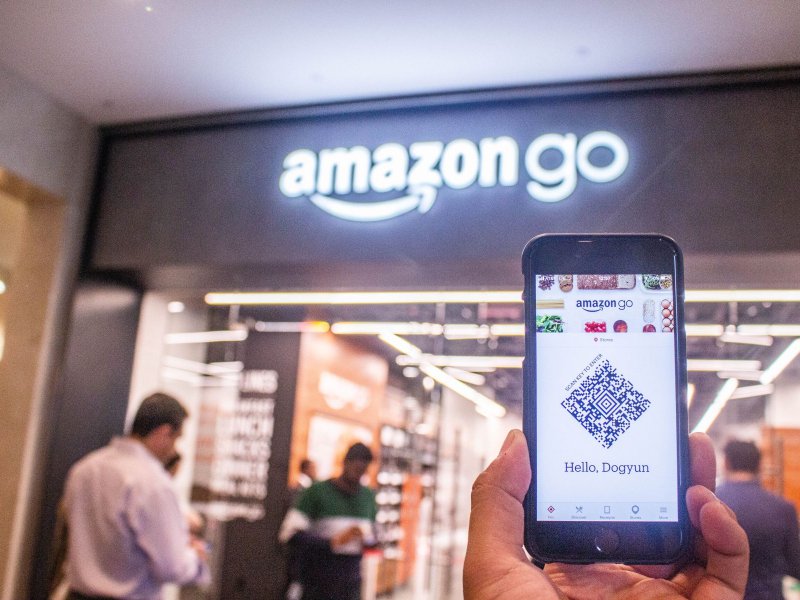
One example of how robots are affecting international marketing is Amazon Go. This brilliant idea allows shoppers to walk into a store, pick up what they need, and leave without waiting in line or paying at the register. There are no cashiers needed- just robots! That’s not all either- Amazon plans to expand its total number of stores from 880 locations worldwide to 2,000 by 2021. What does this mean for international marketing?
Well, it means that brands must figure out how they can remain relevant and connected with customers as robotics become more common in everyday life.
In order for brands to stay ahead of the curve, they have to think about their customer experience holistically- from their website design down to their product packaging on the shelves- so that customers feel like they're getting something unique when walking into a store or visiting their website.
More People Will Be Travelling Overseas
With more people traveling internationally, there is a more significant opportunity for brands to reach out to them.
This is especially true with the growing trend of global tourism, which means more people travel within their own country and across borders to other countries.
As consumers become more and more aware of what brands are doing, it’s inevitable that they will demand better service from international companies. These brands will need to stay on top of trends like artificial intelligence and blockchain so that they can offer customers an experience worth traveling abroad for.
Bottom line
International marketing is moving at lightning speed, and it will only continue to get even faster in the future. As digital becomes more prominent, so does the need for brands to be able to reach customers wherever they may be.
With consumers becoming more aware of what brands are doing, companies need to be fast and agile in order to stay ahead of the curve.
With this rapid pace of change comes some new challenges for marketers, but also some exciting opportunities as well. It’s never been easier for businesses with a global presence to connect with customers in overseas markets, which will only become more critical as time goes on.
International marketing presents some new challenges but also new opportunities. It’s never been easier for businesses with a global presence to connect with customers in overseas markets, which will only become more important as time goes on.

Ranu Kumari is a Professional Writer and a Marketing enthusiast who currently runs her own Marketing Consultancy, LatitudeBOX. She has written promotional articles for multiple brands and has published her work in Scopus indexed journals. She is passionate about expressing her thoughts and ideas to connect with her readers in a voice that they understand.
